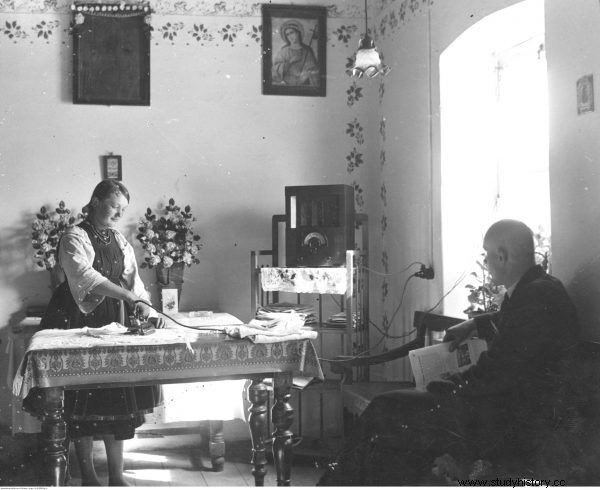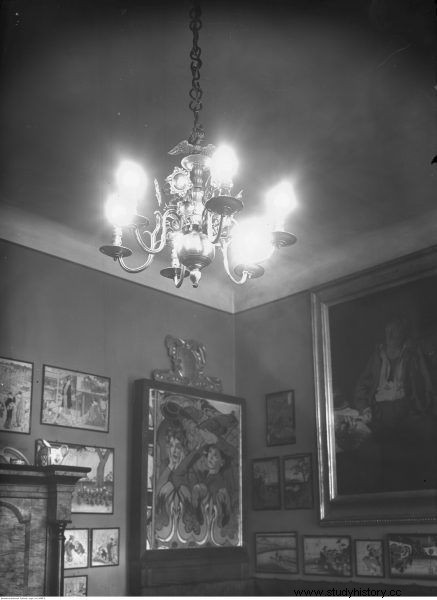Pre-war journalists emphasized that even a little smart man can handle any electrical equipment. But a woman? She was in mortal danger from the very moment the light was turned on ...
A reporter of the Lodz newspaper "Głos Poranny" assured in 1934 that no special skills are needed to operate modern electrical devices. Even a man, a straw widower during summer trips, was able to use, for example, an electric stove. He didn't have to starve or eat out because:
Without any hassle and effort, having an electric cooker, she can prepare all her dishes without smelling the foul smell and without even getting her hands dirty.

The girl from the town. A painting by Władysław Żurawski from 1932
I have already written about this electricity propaganda in other articles (click to read it). But was it really that simple? And completely safe?
We must remember that electric cables before the war differed significantly from those with which we connect devices today. The plugs were porcelain back then and initially did not even have an earthing connection.

A woman ironing with an electric iron, in the background there is a radio receiver - also powered by electricity. Photo from 1936.
Not as current as today
Also the cable looked different. First of all, it was much thicker than today. It resembled the one used to connect a monitor to a desktop computer, rather than a thin charger.
In 1935, the magazine for women, "Lady of the House", printed a detailed instruction on how to handle such a plug so as not to damage it:
We must remember that the cords must be handled with care, not to allow excessive twisting and knoting, and when removing the plug from the socket, never pull the cord but remove the plug itself.
And it was better to remember these tips, because pre-war electrical installations - without security and simply unreliable - were much more dangerous than today. Today we would say that they were dangerous to everyone. However, the pre-war press emphasized that mainly women were at risk. So beings less reasonable and not understanding the seriousness of the situation ...
Traps for the ladies of the house
The daily "Echo" published in 1934 the text entitled Traps for the ladies of the house . It enumerated successive moments from one day of an ordinary Polish woman, which could lead to a fatal tragedy. The first threat appears during the morning bath:
After a quarter of an hour of cheerful splashing in the water, she reaches for a towel hanging from a nail to wipe her face. But it was the last move she made in her life. The maid finds her after some time without life in the bathtub. What happened?
Here is the nail on which the towel hung was so unhappily pounded into the wall that it came into contact with the wire of the electric light. When the lady touched the nail with a wet hand, she was killed electric current.

House Interior. Visible old candlestick converted into an electric chandelier. 1938.
Or at least "would stay", the editor assumes that the accident did not happen and moves on to the next, no less macabre point of the schedule. The hostess, in a hurry to leave, grabs her blouse, but it turns out to be "a bit trimmed":
But what does an electric iron do? It quickly liquefies the blouse before ironing it, while in a hurry some water is spilled onto the carpet. Then he takes the iron with his still wet hand and stands with his bare foot on the damp carpet. And here's the misfortune ready.
A large number of such murderous irons can be seen in the display windows of the electro-therapeutic institute, demonstrating how carefully these products of modern technology should be handled.

Devices installed in Miejskie Zakłady Elektrycznych in Gdynia. 1932
Further dangers are associated with cooking and ... switching on the room lamps ("Probably many people have already experienced a lighter or stronger shock when unscrewing the contact to make the light. be sometimes fatal "- emphasizes the editor). The lady of the house is also not safe at the very end of the day, when she "goes to bed to enjoy reading before falling asleep":
An electric lamp on a metal foot on a bedside table is not always as innocent as it looks. The wire of the electric cable passing through metal holes, often devoid of an insulating layer in some places, comes into contact with the metal. If you touch the metal base carelessly, you run the risk of electric shock .
And one can only guess how much I will give, having read the said article, however, decided not to turn off the light at night. Just in case ... On the other hand, it is worth asking:why were men not threatened with similar texts? And why weren't they made into idiots incapable of "putting their feet up on a damp carpet"?
***
Sources:
The article is based on the sources and literature used by the author while working on the book "Twenty years from the kitchen. Culinary history of pre-war Poland ” .
